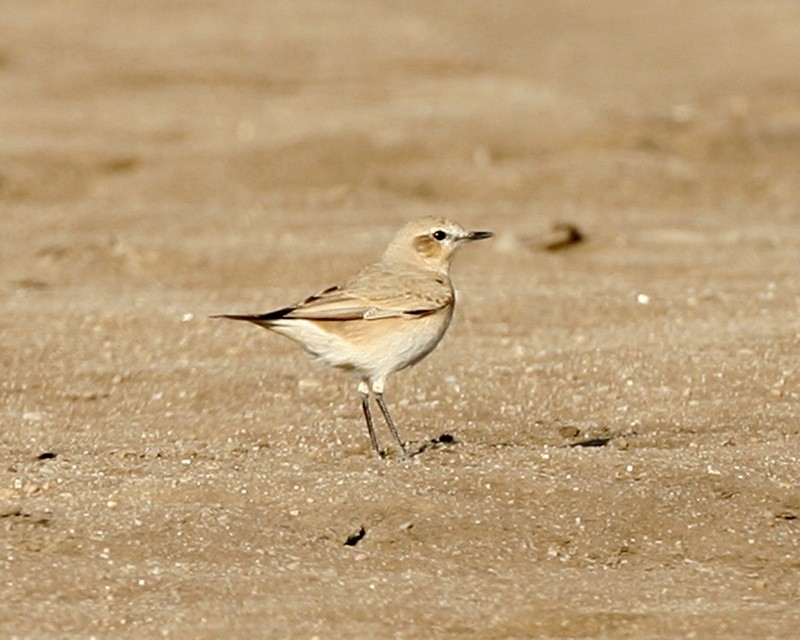Isabelline Wheatear
A species of Wheatears Scientific name : Oenanthe isabellina Genus : Wheatears
Isabelline Wheatear, A species of Wheatears
Botanical name: Oenanthe isabellina
Genus: Wheatears
Content
Description General Info
 Photo By Lip Kee , used under CC-BY-SA-2.0 /Cropped and compressed from original
Photo By Lip Kee , used under CC-BY-SA-2.0 /Cropped and compressed from original Description
Male and female isabelline wheatear are similar in appearance. The upper-parts are a pale sandy brown with an isabelline tinge (isabelline is a pale grey-yellow, fawn, cream-brown or parchment colour). The lower back is isabelline and the rump and upper tail-coverts are white. The tail feathers are brownish-black with a narrow edge and tip of buff and a large white base. In the outer tail feathers this occupies more than half the length of the feather but in the central feathers it is about one third. There is an over-eye streak of creamy white and the ear-coverts are pale brown. The chin is pale cream and the throat pale buff. The breast is sandy or isabelline buff and the belly creamy white. The under tail-coverts are pale buff and the under wing-coverts and axilliaries white with dark bases. The wing feathers are brownish-black, tipped and edged with creamy buff. The beak, legs and feet are black and the irises are brown. At a length of 16.5 centimetres (6.5 in) it is rather larger and also paler in colour than the northern wheatear (Oenanthe oenanthe). The beak is longer than that bird and the ear-coverts are paler but otherwise the birds are very similar in appearance and could be confused. The plumage is moulted twice a year, there being a complete moult in late summer and a partial moult of the body feathers in mid-winter. The call note is a chirp, and a loud whistle is sometimes emitted. The song has been described as lark-like and starts with a croaking noise followed by various whistles and includes mimicry of the voices of other birds. 
Size
17 cm
Colors
Brown
Black
Gray
White
Nest Placement
Ground
Feeding Habits
Isabelline Wheatear primarily feed on insects such as ants, grasshoppers, moths, flies, mites, spiders, and larvae with occasional seeds. They forage on the ground, probing the soil, or sometimes catching prey mid-air.
Habitat
The isabelline Wheatear favors arid, sparsely vegetated habitats such as dry plains, semi-deserts, and steppe regions with a special affinity for areas with burrowing rodent activity. They live at elevations as high as 4000 meters, extending up to 4600 meters on the Tibetan Plateau. In winter, they reside in African lowlands, preferring semi-arid grasslands with light vegetation.
Dite type
Insectivorous
General Info
Feeding Habits
Bird food type
Sounds
Call
Recording location: China
Song
Recording location: Ethiopia
Behavior
The isabelline wheatear is an active and restless bird, moving across the ground with long hops, flitting into the air and perching on eminences or small bushes. Its posture is rather upright and it is constantly bobbing about and flaring, raising and lowering its tail. It sometimes flutters into the air to catch insect prey but mostly forages along the ground, probing the soil with its beak. Its diet includes ants, grasshoppers, moths, flies, mites, spiders and insect larvae, and it sometimes eats seeds as well. Isabelline wheatears are solitary birds in their winter quarters and may associate with other Oenanthe species during migration. On arrival at their breeding grounds they establish territories. The male isabelline wheatear displays to the female by drooping and then spreading his wings while singing, leaping a short distance in the air, or flying up fifteen metres (fifty feet) or so, hovering and performing stunts, singing all the while, before landing again beside the female. The nest is usually underground, normally in the empty burrow of a pika, ground squirrel or mole rat, or they may excavate a fresh burrow. The nest is bulky and is composed of dried grasses. Four to six pale blue eggs are laid, usually unmarked but sometimes with a scattering of reddish speckles. The average size of the eggs is 22.16 by 16.6 millimetres (0.872 in × 0.654 in). Both parents feed the chicks with small caterpillars and other insects. After they leave the nest, the chicks continue to be fed for about two weeks but after this the parents drive them out of the territory. The breeding season starts at the end of March in Turkey but does not commence until May in Central Asia. There are probably two broods in the southern parts of the range. 
Distribution Area
The isabelline wheatear is a migratory species with an eastern palearctic breeding range. This extends from Southern Russia, the Caspian region, the Kyzyl Kum Desert and Mongolia to Afghanistan, Iran, Iraq, Saudi Arabia, Syria, Jordan and Israel. It winters in Africa and northwestern India. It has occurred as a summer vagrant to Greece, Cyprus, Algeria and Tunisia. In the breeding season the isabelline wheatear is found in open country, barren tracts of land, arid regions, steppes, high plateaux and on the lower slopes of hills. In its winter quarters it occupies similar habitats in semi-arid regions, open country with sparse scrub and the borders of cultivated areas, showing a particular liking for sandy ground. 
Species Status
Not globally threatened.
Scientific Classification
Phylum
Chordates Class
Birds Order
Perching birds Family
Old world flycatchers Genus
Wheatears Species
Isabelline Wheatear